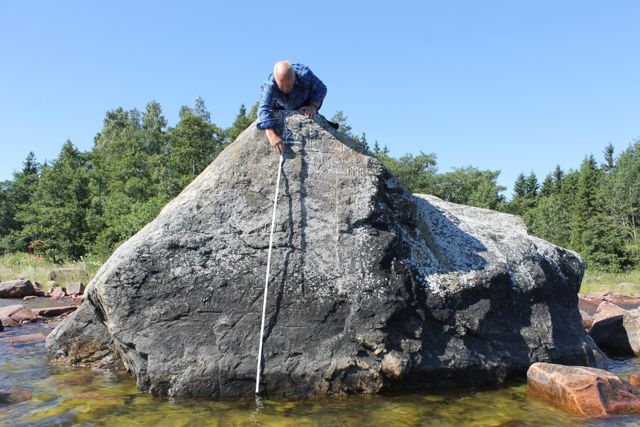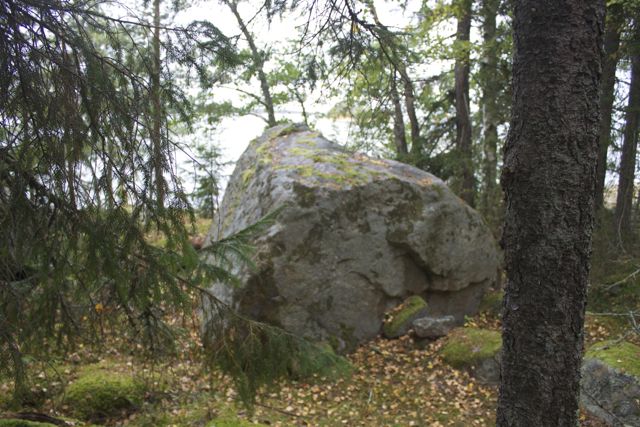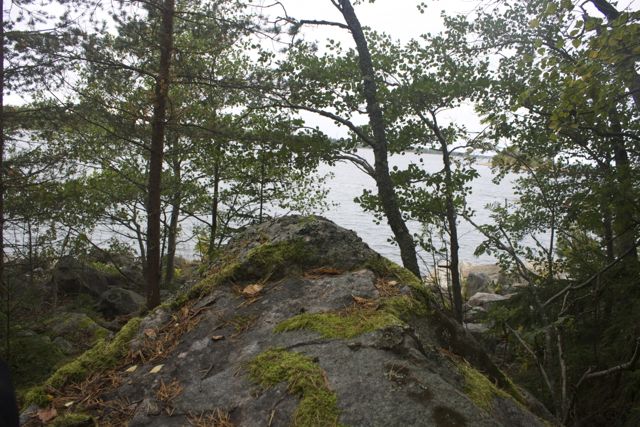
In a trackless pine forest by the shore of the Baltic Sea in Sweden is a largely forgotten landmark in the history of sea level change.

In the 16th century there were no trees here, this elephant-sized rock was almost submerged by the sea and seals sunbathed on the top in the brief Nordic summers. (…It was rediscovered, after some great detective work, by Swedish sea level expert Martin Eckman in 2012)
The puzzle around the Baltic Sea, like here on the Iggon Peninsula about 175 kms (110 miles) north of Stockholm, is that the land is rising at one of the fastest rates in the world of almost a centimetre a year in some places, more than offsetting global sea level rise.
In the early 18th century Swedes knew that river estuaries were always getting shallower around the Baltic Sea, ports had to be dredged, whole coastal towns had shifted inland since Viking days.
But they had no idea why – some Christians even speculated that it was a lingering sign of Noah’s Flood, with the water still gurgling away somewhere into the ground. It took until the 19th century for scientists to work out what was really going on – the entire Nordic region has been rebounding since the end of the last Ice Age 10,000 years ago lifted a vast weight of ice off the land, like a mattress slowly regaining its shape after you get up.
The sea level fall conundrum drew experts from across Europe to the low-lying Baltic coast.
Sweden’s Anders Celsius, most famous for inventing the temperature scale of his name and who was a professor of astronomy at Uppsala University, decided to figure out at least the rate of change. But he of course had a problem – in the early 18th century there were no benchmarks.
So he then struck on the idea of tracking down “seal rocks” – rocks whose tops poked out of the sea and where seals used to bask. When close to land, these were valuable bits of real estate in the 16th century since hunters could sneak up on unwitting seals lolling in the sunshine so the rocks were often marked on maps. The rock above was one of those Celsius identified – it was owned by a farmer, “Rich Nils”, in the mid-16th century on what was then the island of Iggon (Sea level fall has since connected the island to the mainland). Celsius visited in 1731 and knew that the top of the rock must have been just above sea level to be attractive to seals in Rich Nils’ time.
This is what the view would have looked like for a seal in the mid-16th century (ok, try to forget the trees, the leaves, the moss, and the fact that the sea is nowhere near):
By the time Celsius visited no seal could have climbed the rock since the water had sunk to around the base. And no self-respecting seal would even dream of climbing it now – the bottom is probably about five feet (1.5 metres) above sea level and maybe 10 metres from the sea.
So this was Celsius’ drawing – it doesn’t look much like the rock at the top but it may be the angle the photo was taken at, or perhaps Celsius wasn’t great at drawing and was just making the point? Either way, no other rock matches the 16th century maps of Rich Nils’ land, according to Eckman (…and my own wanderings around that bit of the forest).
Sea level in 1731 was at E-F and Celsius reckoned that in the 1563 it was at C-D, an estimated fall of 237 cms in 168 years, or an annual decline of 1.4 cms. That’s a bit of an overestimate (0.8 cm is now the accepted rate), but amazing based on 16th century maps.
(Even now, locals say that Rich Nils buried a pot of gold and other coins on Iggon: some have even used metal detectors to try to find it around a dip in the ground that may, or may not, be the cellar of his home).
To check out Celsius’ estimates, boatman Sture Sundin helped by taking me out to Lovgrund island to the south of Iggon, where Celsius had a mark scratched into a rock in 1731 as a benchmark to help later generations judge the Baltic Sea level fall. You can see Sture above “1731”, and subsequent dates cut as the water fell, below:

So we weren’t as scientific as Celsius – our main bit of expert equipment was a 2 metre folding ruler that Sture brought along from his garden.
Still, as you can see (bottom picture) the water is almost exactly 2 metres below the 1731 mark – an average of a fall of 0.7 centimetres a year over 282 years to 2013. That’s pretty close to the real estimate, even though our measurements didn’t take account of the state of the tide, which doesn’t vary a lot in the Baltic, and maybe the rock face isn’t quite vertical, etc).
So the Baltic area is one of the few places in the world where the land is rising faster than sea levels – other parts of the Arctic are also rising.
But even in Sweden, local authorities are wondering if they have to worry that the global rate of sea level rise will ever catch up with the local rate of land rise about 80 cms a century. That’s a big jump from the current worldwide rate of 30 cms a century, but not unthinkable if sea level rise accelerates to the upper end of climate scientists’ scenarios, of about a metre by 2100.
So even in the gloomiest cases of sea level rise, the Baltic region will be one of the few places where coasts won’t suffer much, if at all.




